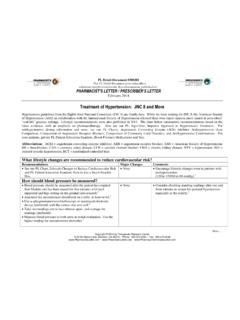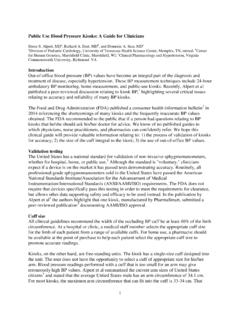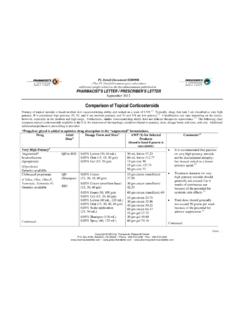Transcription of Treatment of Hypertension: JNC 8 and More
1 pl detail - document #300201. This pl detail - document gives subscribers additional insight related to the Recommendations published in . PHARMACIST'S LETTER / PRESCRIBER'S LETTER. February 2014. Treatment of Hypertension: JNC 8 and More Hypertension guidelines from the Eighth Joint National Committee (JNC 8) are finally here. While we were waiting for JNC 8, the American Society of Hypertension (ASH) in collaboration with the International Society of Hypertension released their own expert opinion piece aimed at prescribers'. real-life practice settings. Lifestyle recommendations were also published in 2013. The chart below summarizes recommendations based on the latest evidence, with an emphasis on pharmacotherapy. Also see our PL Algorithm, Stepwise Approach to Hypertension Treatment . For antihypertensive dosing information and more, see our PL Charts, Angiotensin Converting Enzyme (ACE) Inhibitor Antihypertensive Dose Comparison, Comparison of Angiotensin Receptor Blockers, Comparison of Commonly Used Diuretics, and Antihypertensive Combinations.
2 For your patients, get our PL Patient Education Handout, Blood Pressure Medications and You. Abbreviations: ACEI = angiotensin-converting enzyme inhibitor; ARB = angiotensin receptor blocker; ASH = American Society of Hypertension;. BB = beta-blocker; CAD = coronary artery disease; CCB = calcium channel blocker; CKD = chronic kidney disease; HTN = hypertension; ISH =. isolated systolic hypertension; RCT = randomized controlled trial What lifestyle changes are recommended to reduce cardiovascular risk? Recommendations Major Changes Comments See our PL Chart, Lifestyle Changes to Reduce Cardiovascular Risk None Encourage lifestyle changes even in patients with and PL Patient Education Handout, How to Eat a Heart-Healthy prehypertension Diet. (120 to 139/80 to 89 mmHg).2. How should blood pressure be measured? Blood pressure should be measured after the patient has emptied None Consider checking standing readings after one and their bladder and has been seated for five minutes with back three minutes to screen for postural hypotension, supported and legs resting on the ground (not crossed).
3 2 especially in the Arm used for measurement should rest on a table, at Use a sphygmomanometer/stethoscope or automated electronic device (preferred) with the correct size arm Take two readings one to two minutes apart, and average the readings (preferred). Measure blood pressure in both arms at initial evaluation. Use the higher reading for measurements More.. Copyright 2014 by Therapeutic Research Center 3120 W. March Lane, Stockton, CA 95219 ~ Phone: 209-472-2240 ~ Fax: 209-472-2249. ~ ~ ( pl detail - document #300201: Page 2 of 6). How is hypertension diagnosed? Recommendations Major Changes Comments Confirm the diagnosis of HTN at a subsequent visit one to four None Consider home blood pressure monitoring or weeks after the If blood pressure is very high ( , systolic ambulatory blood pressure monitoring if white coat 180 mmHg or higher), or timely follow-up unrealistic, Treatment can HTN is be started after just one set of Who should be treated with pharmacotherapy?
4 Recommendations Major Changes Comments JNC 8:1 Higher cut-off for Continue lifestyle changes in addition to Patients <60 years of age: start pharmacotherapy at elderly. 140/90 mmHg. Lower threshold for Patients with diabetes: start pharmacotherapy at diabetes, CKD, and 140/90 mmHg. CAD no longer Patients with CKD: start pharmacotherapy at recommended. 140/90 mmHg. Patients 60 years of age and older: start pharmacotherapy at 150/90 mmHg. ASH:2. Patients younger than 80 years of age: start pharmacotherapy at 140/90 mmHg Patients 80 years of age and up: start pharmacotherapy at 150/90 mmHg. Consider starting at 140/90 mmHg in those with diabetes or CKD. Patients with uncomplicated stage 1 HTN: (140 to 159/90 to 99 mmHg without CV abnormalities or risk factors): consider six to 12 months of lifestyle changes ( , weight loss, sodium restriction, exercise, smoking cessation) alone before pharmacotherapy. More.. Copyright 2014 by Therapeutic Research Center 3120 W.
5 March Lane, Stockton, CA 95219 ~ Phone: 209-472-2240 ~ Fax: 209-472-2249. ~ ~ ( pl detail - document #300201: Page 3 of 6). What is the goal blood pressure? Recommendations Major changes Comments JNC 8:1 Higher goals for In patients 60 years of age and older, no need to Patients <60 years of age: <140/90 mmHg elderly, diabetes, back off on tolerated Treatment if lower systolic Patients with diabetes: <140/90 mmHg [Evidence level A; high- CKD, and CAD vs ( , <140 mmHg) quality RCTs]7-10 JNC 7. Use clinical judgment; consider risk/benefit of Patients with CKD: <140/90 mmHg Treatment for each individual when setting Patients 60 years of age and older: <150/90 mmHg [Evidence level Unproven clinical benefit of lower targets previously B; lower quality RCTs].4,5 recommended in diabetes, CKD, and ASH:2. Patients younger than 80 years of age: <140/90 mmHg Patients 80 years of age and up: systolic of up to 150 mmHg is acceptable [Evidence level A; high-quality RCT].
6 3 A goal of <140/90 mmHg can be considered for those with diabetes or CKD. Patients 18 to 55 years of age: lower target ( , <130/80 mmHg). can be considered, per prescriber discretion, if Treatment is tolerated. However, evidence of additional benefit vs goal of <140/90 mmHg is lacking. CKD with albuminuria: some experts recommend <130/80 More.. Copyright 2014 by Therapeutic Research Center 3120 W. March Lane, Stockton, CA 95219 ~ Phone: 209-472-2240 ~ Fax: 209-472-2249. ~ ~ ( pl detail - document #300201: Page 4 of 6). What pharmacotherapy is recommended? Recommendations Major Changes Comments JNC 8:1 Thiazides no longer Choose once-daily or combination products to Nonblack, including those with diabetes: thiazide, CCB, ACEI, or given preference as simplify the ARB initial In general, wait two to three weeks before African American, including those with diabetes: thiazide or CCB JNC 8 options for increasing dose or adding new CKD: regimen should include an ACEI or ARB (including African diabetes same as for Pivotal studies showing clinical benefits of treating Americans) the general HTN included a Can initiate with two agents, especially if systolic >20 mmHg above population; no Consider chlorthalidone or indapamide over goal or diastolic >10 mmHg above goal.
7 Evidence they hydrochlorothiazide due to better evidence of If goal not reached: benefit differently stress adherence to medication and lifestyle from general Because patients with diabetes are at increased risk increase dose or add a second or third agent from one of the hypertensive of nephropathy, coronary artery disease, and heart recommended classes. failure, conditions known to benefit from ACEIs and choose a drug outside of the classes recommended above only Specific ARBs, it makes sense to choose one of them first- if these options have been exhausted. Consider specialist pharmacotherapy line for hypertension in patients with referral. recommendations For HTN, beta- and alpha-blockers have worse CV. provided for outcomes data than the recommended ASH:2 African African Americans have high stroke CCBs Nonblack <60 years of age: ,2 provide better stroke prevention and blood pressure First-line: ACEI or ARB De-emphasis in reduction in African Americans vs Second-line (add-on): CCB or thiazide JNC 8 on choice of Thiazides produce better CV outcomes (including Third-line: CCB plus ACEI or ARB plus thiazide agent for reduced stroke risk) than ACEIs in African Nonblack 60 years of age and older: compelling First-line: CCB or thiazide preferred, ACEI, or ARB indications; focus is African Americans tend to be salt-sensitive.
8 2 This Second-line (add-on): CCB, thiazide, ACEI, or ARB (don't on BP control using may explain their relatively poor response to use ACEI plus ARB) four medication Encourage sodium restriction. Third-line: CCB plus ACEI or ARB plus thiazide classes with Most African Americans will need at least two African American: outcomes evidence antihypertensives to control blood from African Americans and nonblacks have similar First-line: CCB or thiazide Second-line (add-on): ACEI or ARB responses to combination therapy ( , thiazide plus Third-line: CCB plus ACEI or ARB plus thiazide ACEI; CCB plus ACEI).2. Do not use an ACEI plus an ARB; no added benefit, more side effects ( , hyperkalemia).1,2,12. Continued . More.. Copyright 2014 by Therapeutic Research Center 3120 W. March Lane, Stockton, CA 95219 ~ Phone: 209-472-2240 ~ Fax: 209-472-2249. ~ ~ ( pl detail - document #300201: Page 5 of 6). What pharmacotherapy is recommended? (continued).
9 Recommendations Major Changes Comments Comorbidities (ASH): Thiazides and CCBs reduce systolic BP more than Diabetes: diastolic First-line: ACEI or ARB [Evidence level C; consensus] (can start with CCB or thiazide in African Americans). Second-line: add CCB or thiazide (can add ACEI or ARB in African Americans). Third-line: CCB plus ACEI or ARB plus thiazide CKD. First-line: ARB or ACEI (ACEI for African Americans). Second-line (add-on): CCB or thiazide Third-line: CCB plus ACEI or ARB plus thiazide CAD: First-line: BB plus ARB or ACEI. Second-line (add-on): CCB or thiazide Third-line: BB plus ARB or ACEI plus CCB plus thiazide Stroke history: First-line: ACEI or ARB. Second-line: add CCB or thiazide Third-line: CCB plus ACEI or ARB plus thiazide Heart failure: ACEI or ARB plus BB plus diuretic plus aldosterone antagonist. Amlodipine can be added for additional BP control. (Start with ACEI, BB, diuretic. Can add BB even before ACEI.)
10 Optimized. Use diuretic to manage fluid.)13. Users of this pl detail - document are cautioned to use their own professional judgment and consult any other necessary or appropriate sources prior to making clinical judgments based on the content of this document . Our editors have researched the information with input from experts, government agencies, and national organizations. Information and internet links in this article were current as of the date of publication. More.. Copyright 2014 by Therapeutic Research Center 3120 W. March Lane, Stockton, CA 95219 ~ Phone: 209-472-2240 ~ Fax: 209-472-2249. ~ ~ ( pl detail - document #300201: Page 6 of 6). Levels of Evidence 4. JATOS Study Group. Principal results of the In accordance with the trend towards Evidence-Based Japanese trial to assess optimal systolic blood pressure in elderly hypertensive patients (JATOS). Medicine, we are citing the LEVEL OF EVIDENCE. Hypertens Res 2008;31:2115-27.


